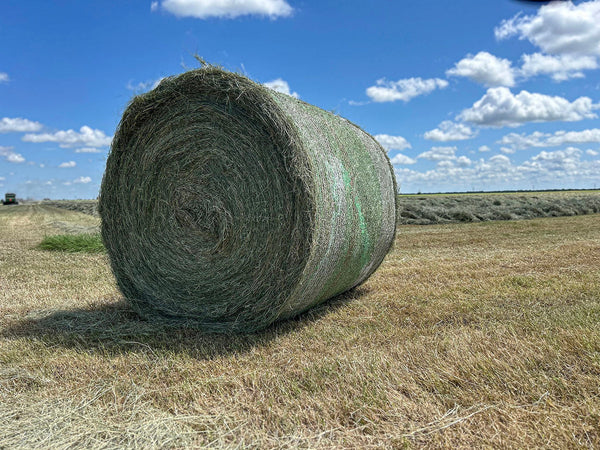Hay There!
Behind the Bale: Why Hay Quality Matters at Wellborn 2R
At Wellborn 2R Ranch in Henrietta, Texas, greatness doesn’t start with the steak — it starts with the soil.
Before our cattle ever reach the pastures — and long before a steak hits your plate — we’re focused on something even more foundational: the land itself. Every bale of hay we produce reflects the care we put into nurturing our fields with sustainability, precision, and purpose.

We’re not just growing grass — we’re growing fuel for the herd that fuels your table. Every step of our haymaking process is intentional, from soil health to the timing of each cut, ensuring nutrient-rich hay that supports healthy cattle and premium-quality beef.
“Hay season” begins after the last frost of spring when warm-season grasses start their green-up — typically in early to mid-April here in North Texas — and wraps up with the first hard freeze in late October or early November. During that six-month window, it’s as the saying goes: “Make hay while the sun shines.”
The Key Ingredient: Coastal Bermuda Hay

When it comes to feeding cattle, not all hay is created equal. Across Texas and much of the southern U.S., one name stands above the rest — Coastal Bermuda. Known for its high nutritional value, digestibility, and consistent performance, it’s no wonder this hay has become a rancher’s favorite for keeping herds healthy and productive.
Coastal Bermuda provides an ideal balance of protein and energy. When grown on fertile soil and harvested at the right stage, it can deliver 10–16% crude protein and 55–60% total digestible nutrients (TDN). That means our cattle get the nutrition they need to maintain body condition, gain weight efficiently, and, for cows, produce quality milk. It's fine stems and leafy texture make it highly palatable, so cattle eat more and waste less — something every rancher appreciates.
Production and Consistency We Can Count On
Developed by Texas A&M University in the 1940s, Coastal Bermuda was bred to thrive in the hot, humid climates of the southern plains. It’s a warm-season perennial grass that loves sunshine, tolerates drought once established, and bounces back quickly after cutting. Under good management, ranchers can often get four to six cuttings per year, providing a steady, reliable hay supply even through long summers.
At Wellborn 2R Ranch, we’re a dryland hay operation, relying solely on rainfall — no irrigation. That makes every bale we harvest even more meaningful. Because Coastal Bermuda is a hybrid, it grows uniformly and consistently, helping us plan feed rations with confidence and ensuring our herd receives the same high-quality nutrition season after season.

Our coastal Bermuda hay pastures are dry land farmed, relying on rain. A "warm season" grass, it starts growing after last frost of the years and goes dormant after first hard freeze. We cut and bale hay approximately every 30 days, giving us 5-6 cuttings each year.
How We Use Coastal Bermuda on the Ranch
While Coastal Bermuda hay is prized for its quality, we use it with intention. Timing and balance are everything when it comes to managing pastures and maintaining healthy cattle year-round.
We grow Bermuda during the summer months, when native forage is abundant and naturally rich in nutrients for grazing. Rather than relying on it year-round, we put up our Bermuda hay as a strategic supplement for the colder months. When warm-season native grasses go dormant and lose nutritional value, our stored Bermuda hay fills the gap. Its high protein and nutrient density help maintain body condition and energy through the winter, keeping our cattle strong until spring pastures return.
By managing our hay this way, we work in rhythm with the land—maximizing nature’s abundance during the growing season and preserving quality forage for when the pastures need a little help. It’s a sustainable, regenerative approach that keeps both the cattle and the countryside thriving.

Freshly cut and raked hay ready for the baler.
Sustainable Hay Production Fuels Better Beef
At Wellborn 2R Ranch, sustainable ranching isn’t just a buzzword—it’s a way of life. We treat our hay fields like the living ecosystems they are. That means managing nutrients carefully, timing our cuts precisely, and avoiding overuse of chemicals. About 30 days after fertilization, we cut—hitting the sweet spot for maximum nutrient density.
Cut. Rake. Bale. It sounds simple, but every step is timed for optimal sustainability and cattle nutrition. After cutting, we let the sun do its work, allowing the hay to dry for about two days to prevent mold and preserve integrity. Before baling, we test moisture in each roll — our gold standard is 20% or less. Anything higher risks spoilage, and we won’t feed that to our herd.
Sustainability isn’t just about protecting the environment — it’s about producing clean, nutritious feed that supports animal health, minimizes waste, and builds long-term resilience on the ranch. That commitment to quality shows up in every bite of Wellborn 2R Beef.

Haymaking: A Team Effort
Sometimes, cutting hay feels more like a race than a routine. Our last cutting was one of those times.
With a summer storm rolling in, two cowboys worked the field — one raking, one baling — racing the clouds. We rolled 493 bales before the rain hit, missing it by just 20. Out here, you don’t fight the weather — you work with it. Since we depend on the rain to grow our hay, we take it when it comes and plan around it.
That’s sustainability in action—staying adaptable, listening to the land, and working with nature, not against it.

Baler releasing a fresh, tightly rolled bale of hay.
Why It Matters
Healthy land grows healthy hay.
Healthy hay grows healthy cattle.
Healthy cattle produce the kind of beef that lives up to the Wellborn 2R name.
This isn’t just about yield — it’s about nutrient-rich forage, regenerative practices, and a deep respect for the land we’re privileged to work. When you choose Wellborn 2R Beef, you’re choosing a product grown the right way — from the grass roots of our hay fields to the ribeyes on your plate.
Every bale we grow reflects the pride we take in doing things right — from the soil to the supper table.
Because our cattle, and you, are worth it.




